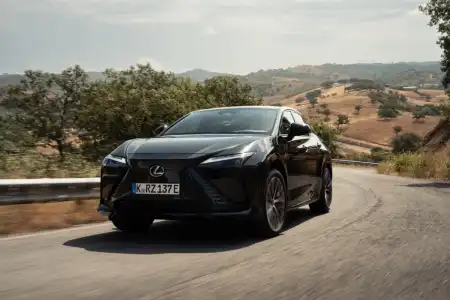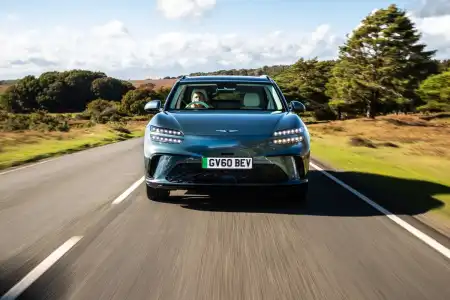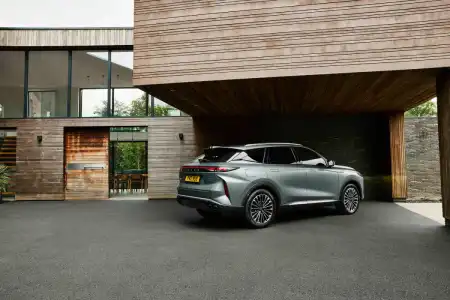- Impressive electric range
- Uncompromised cargo volume
- Hi-tech car-like cabin
- Payload volumes slightly reduced from the diesel model
- Regenerative braking adjustment is clumsy
- Electricity prices in a state of flux
Introduction
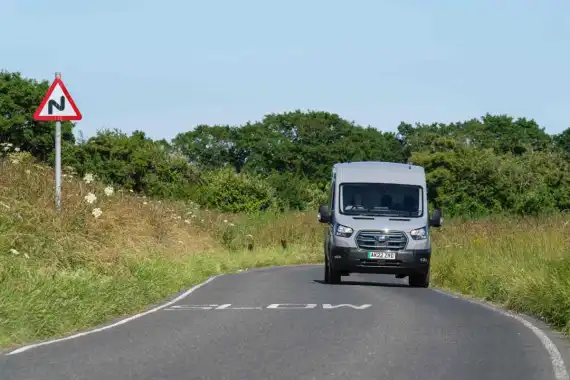
There’s arguably no more important vehicle to Ford UK than the Transit, and there’s no more important vehicle to get right when it comes to electrification. It’s taken Ford long enough to get started, with the likes of Vauxhall, Renault and even Maxus already bringing full-size electric vans to the market, but does being fashionably late to the party mean you’ve got some new tricks to show off?
Ford has played it safe when it comes to styling, avoiding the temptation to create a futuristic aesthetic that could divide opinions. Barring a few blue highlights dotted around the van, you’d be hard-pushed to tell if this was the E-Transit or a regular diesel-powered model. While it may not be classically beautiful, if safe and predictable, with all the significant changes taking place under the skin.
Converting an existing model from diesel to electric power is fraught with difficulties. As the Transit was never designed to be an eLCV, Ford has had to make some significant changes. It’s gone beyond just bolting in an electric motor and shoehorning in some batteries, something that tends to leave a vehicle compromised — just look at the efforts from Citroen and Renault to see what can go wrong.
Far from a conversion, the E-Transit is more of a complete re-engineering project. There’s a new rear subframe with independent coil-sprung suspension rather than leaf springs, which creates room for the rear axle-mounted motor. At the same time, the 68kWh battery pack has been slotted underneath the cargo floor without interfering with its capacity. It feels very much like a van designed to be electric from day one, which is something of a miracle.
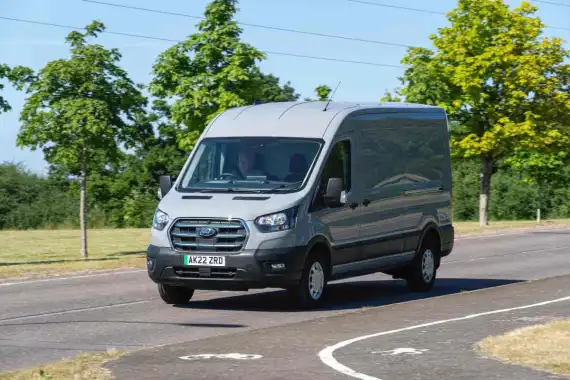
Ford will provide an E-Transit in one of two power outputs; there’s a 269hp model or a lower-output 184hp model, but there’s little to choose between the two in day-to-day driving. The more powerful model doesn’t give you access to all it's got unless you press the throttle all the way down. Unless you need to be first from the lights every time, the 184hp model will likely be all the E-Transit you need.
It’s also likely to be the most popular model, thanks to a fine balance of performance and range. Officially, it’ll manage 196 miles between charges, but that can be dramatically affected by load, weather and journey type. However, Ford is keen to stress a ‘dependable’ range of 100 miles, regardless of how you use the van. That’ll be a more realistic figure for a fully-loaded van, and while it doesn’t sound like much, it’s 40 miles more than the average Transit driver covers in a day.
If you need to stop at a rapid charging station, at 115kW, the E-Transit will go from 15% to 80% battery charge in a little over half an hour — enough time to grab a coffee and a sandwich, and catch up on any messages.
When you’re moving, the E-Transit is the best Transit ever. No hyperbole, it’s just that good, and more than a match for the diesel models. That new suspension has created a van that handles with a surprising level of engagement yet also rides and absorbs the imperfections in the road nicely. It’s comfortable, agile, and — dare we say it — fun to drive.
In urban areas, it’s every bit as good, with the electric motor providing instant power and making manoeuvering a cinch. There’s no gearbox on an electric model, so the drive is smooth and nearly silent.
The cabin is much like the regular Transit but a little bit better. Removing the gear stick and replacing it with a small rotary selector has freed up more space. The same has happened with the handbrake, which has been removed and replaced by an electronic switch mounted by the steering wheel. Passengers will be particularly pleased with the update, especially if you’re the middle passenger when travelling three-up.
You’ll also spot an enormous 12.0-inch infotainment screen mounted in the dashboard’s centre. It’s a crisp, clear and bright display that comes installed with Ford’s latest Sync 4 software which is just about the best in the industry — cars or vans. It’s got everything you’d expect, including Android Auto and Apple CarPlay connectivity, although it’s a shame that the climate control switches have been moved to the screen.
The lack of a rattly diesel engine and constant changes in velocity from changing gear means it’s a calming environment, especially when battling traffic in the city. That’s backed by academic research, which proves you’ll be more relaxed in an eLCV.
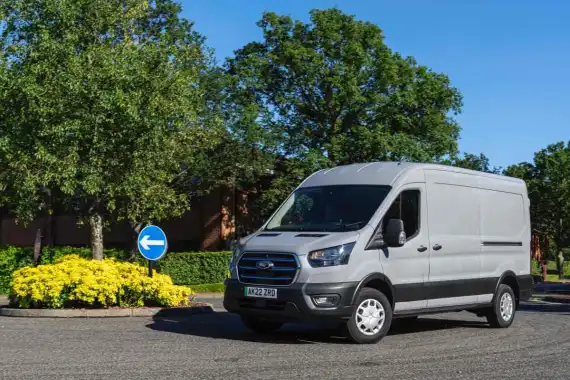
Space & Practicality
Ford offers the E-Transit in three body lengths, two roof heights, and three gross vehicle weights, which adds up to 15 possible combinations — you can’t have the low roof on the longest van if you’re wondering why there aren’t 18 choices.
Payload limits run from 790 right up to 1,758kg, with cargo volumes ranging from 9.5m3 to 15.1m3. While E-Transit payloads are slightly lower than its diesel equivalents, there’s no loss of volume thanks to the clever packaging of the battery pack and motor.
However, as with most vans, the larger the van, the lower the payload limits, so you’ll need to pick carefully and balance volume against weight.
Our L3H2 van, with its 350GVW chassis, was limited to 980kg, with a volume available of 11m3.
Ownership
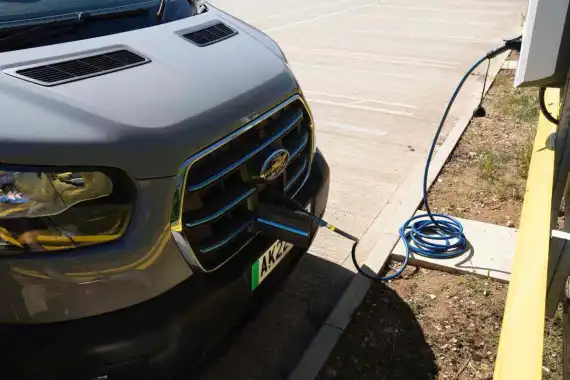
Running Costs
Electric vans are expensive. There’s no escaping from the fact that the E-Transit will set you back £48,000 before VAT, and prices only go up from there. However, while that’s much more than a diesel-powered model, it’s a significant saving over the E-Transit’s frankly less capable rivals.
Leasing rates are generally far more competitive than its rival’s offerings, allowing operators to manage their cash flow and save money. The total cost of ownership might just work in your favour, too.
Much of the cost of running the van will depend on how you pay for your electricity. If you, or your drivers, can take the van home at night and charge on a suitable home charger, it could end up costing as little as 10p per mile, even at today’s sky-high energy rates. At the other end of the range, plug into expensive rapid charges on the motorway network, and that could rise to as much as 30p per mile.
Ford has abandoned its regular service schedules for the E-Transit, as there are fewer parts to maintain. With no complex engine rattling away and little wear on consumables such as the brakes, Ford only wants to see your van once a year, regardless of the mileage you cover.
Part of the confidence it places on your van is thanks to the Ford Pro Liive system (yes, with double-i), which tracks and monitor your van, theoretically alerting you to any problems that need looking at before things go awry. This could save a breakdown and the estimated resulting loss of £600 a day in lost trade and increased costs.
Every E-Transit is covered by a three-year warranty, while the battery pack and electric drive components get extra cover, extending to eight years or 100,000 miles.
Verdict
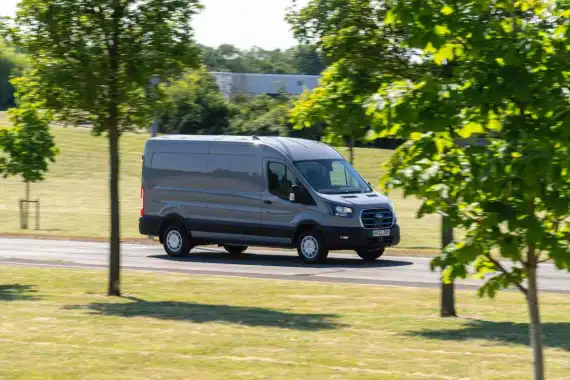
Ford is definitely late to the party, but what an entrance it’s made. There are so few compromises made in turning the Transit into an E-Transit that it’s easy to make a compelling case for it over the regular diesel model. There are plenty of competitive advantages to businesses that could see real cash savings. However, as with any electric vehicle right now, you will need to be sure it matches the needs of your business.
It’s comfortable, refined, smooth and well-equipped. Leasing rates are surprisingly low at the time of writing, and the cost of running it on your fleet is likely to be lower than a more traditional alternative.
Assuming it’s suitable for your business, the E-Transit is the best electric van on the market by some margin.

